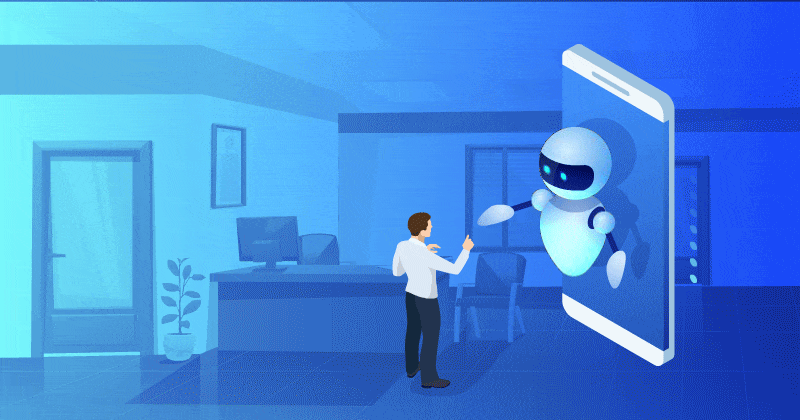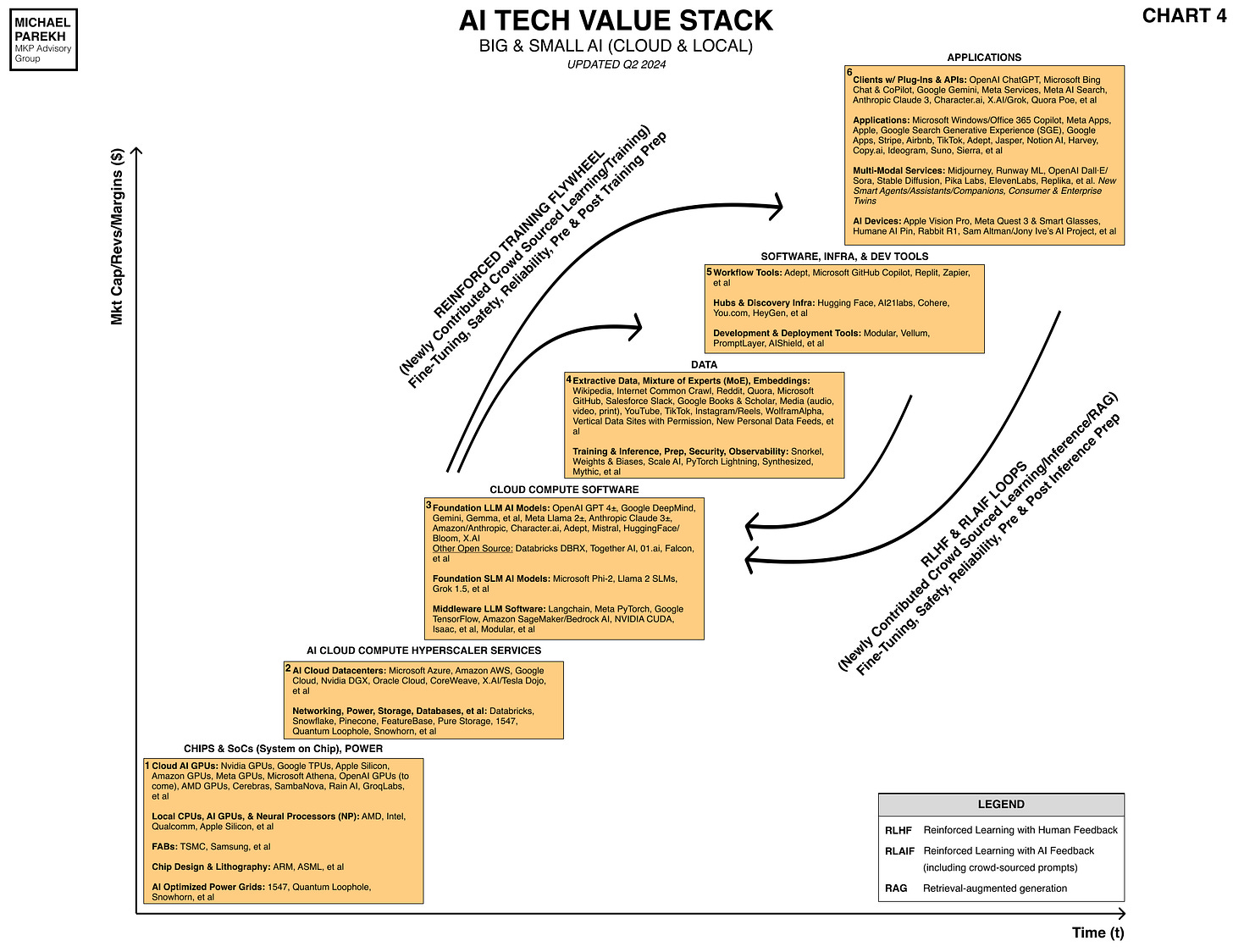AI: Up next, 'Agentic AI Workflows'. RTZ #334
...when 'Smart Agents' start to do General 'Agentic' AI Magic
I’ve talked in earlier posts about ‘Smart Agents’ and AI companions being one of the key set of applications and services for AI companies large and small. And ‘Digital Twins’ being used to traing ‘Synthetic Data’ streams for AI applications for consumers and businesses. These ‘smart agents’ and their activities are part of a key part of what’s being called ‘Agentic AI workflow’ technologies. They encompass the types of services users will see in Box 6 of the AI Tech Wave stack below.
They’re accessed directly via apps like OpenAI’s ChatGPT, Microsoft’s Copilot, Google’s Gemini augmented Search and as of this past week Meta’s ‘Meta AI’. And of course a whole of host tech and AI companies. And companies like Nvidia are doing their best, particularly focused on more efficient ‘Inference processing’ at scale. And they’re slowly and steadily being tested and adopted by enterprises large and small. All the big LLM AI players are ramping up subscription services to end users and businesses.
As described above, these ‘smart agents’ and their activities are part of a key part of what’s being called ‘Agentic AI workflow’ technologies. The Prompt Engineering and AI Institute provides more context in “Agentic Workflows: The Power of AI Agent Collaboration”:
“Discover the potential of Agentic Workflows, an innovative approach to AI collaboration that leverages specialized agents, advanced prompt engineering, and iterative processes to tackle complex problems and drive technological innovation.”
“Three Major Pillars of Agentic Workflows
“The concept of "Agentic Workflows" refers to a more iterative and multi-step approach to using large language models (LLMs) and AI Agents to perform tasks, as opposed to the traditional "non-agent" approach of providing a prompt and receiving a single, direct response.”
“There are three Pillars of the agentic workflows:”
“AI Agents”
“Prompt Engineering”
“Generative AI Networks”
Hundreds if not thousands of companies are involved here across Boxes 3 through 6 in the chart above. Critically important is the ‘Agentic Loop Processing’ I highlight in the ‘Data’ box in the chart above.
This takes the uniquely important ‘Data’ that all models harvest, and perform massive matrix math computations in reinforcement loops across models and data, driven by user queries. This then provides ever more useful and creative AI ‘reasoning’ driven by the probabilistic work being done on massive ongoing data pools and data flows.
The same chart below highlights some representative leading companies in each box.
The Information in “To Unlock AI Spending, Microsoft, openAI and Google Prep ‘Agents’”, provides more context on the current frenetic efforts:
“As many businesses remain cautious about spending on conversational artificial intelligence, AI providers such as Microsoft, OpenAI and Google are racing to make the technology more of a must-have—by introducing new features that can handle complex tasks with little guidance from the customer.”
“Microsoft, for instance, is making software to automate multiple actions such as creating, sending and tracking a client invoice based on their order history or rewriting an application’s code in a different language and verifying that it works as intended, according to current employees. The new software, which OpenAI’s technology will power, would improve upon Microsoft’s current suite of Copilots, which summarize meetings or draft emails. Microsoft is planning to announce some of these capabilities at its annual Build developer conference next month, two of the employees said.”
“The features belong to a class of AI software known as agents, bots that can work toward a goal with minimal guidance from people. OpenAI, Google and Facebook owner Meta Platforms are each developing their own versions of agents. It’s part of the industry’s broader effort to turn the excitement ChatGPT sparked 18 months ago into recurring revenue for a slew of companies that sell such technology. While AI chatbots have wowed the business world with their ability to generate realistic answers or suggest lines of code to a programmer, customers say software that automates harder tasks will be necessary to unlock more spending.”
OpenAI in particular is one to watch in the ‘Agentic AI Workflow’ front for its unfolding plans:
“OpenAI is quietly designing computer-using agents that could take over a person’s computer and operate different applications at the same time, such as transferring data from a document to a spreadsheet.”
This AI agentic work complements OpenAI’s work on AI augmented Search I wrote about a few weeks ago.
The Information piece above goes into the complexity of how AI technologies of today have to be built into the ‘Agentic Workflow’ AI architectures of tomorrow. Much of what is being aspired to has to be built. The whole piece is worth reading.
And it’ll take massive amounts of investment, work across years. And the desired ‘Agentic’ goals being described today will take much longer than we think today, just like ‘Self-Driving’ cars for over a decade now. Smart agents and Agentic workflows have been a computer industry aspiration for decades.
On a personal note, I’ve been working around software and hardware driven ‘Smart Agents’, for a very long time. At Goldman Sachs, I worked with ‘Smart Agent’ software and hardware pioneer General Magic in 1995, almost thirty years ago.
It was staffed with the best and brightest from Apple and other leading technology companies of the time. Led by Founder/CEO Marc Porat. Lot of the current ideas on Agentic software have direct lineage to the ideas being developed back then, particularly with Telescript. They tried hard on a valiant effort to pull the future of ‘Smart Agents’ into that present. Would recommend the movie.
The alumni of General Magic went on to develop many of the key products and technologies of subsequent technology waves, with Android founder Andy Rubin being a key example in the Mobile wave.
Technologies always take longer than we think, and ‘Agentic’ software is no different. The current generation of LLM AI technologies being developed at an exponential rate of improvement in software and hardware, are the single most reason to be more optimistic on an increased pace of progress on Agentic AI software. They should make their general magic real eventually.
But it’s important to understand the challenges and possibilities today and wait for the reality. Stay tuned.
(NOTE: The discussions here are for information purposes only, and not meant as investment advice at any time. Thanks for joining us here)







